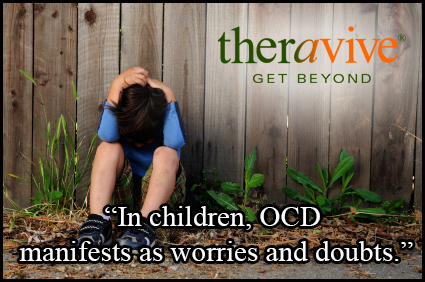 What is the best way to help children from aged five to eight with Obsessive Compulsive Disorder (OCD)? A recent study from Bradley Hospital in Rhode Island offers an interesting insight. Researcher there found that family-based cognitive behavioral therapy is beneficial. They found that developmentally sensitive family-based treatment that included exposure/response prevention was more effective in reducing OCD symptoms and functional impairment in this age group when compared to a structured relaxation program.
What is the best way to help children from aged five to eight with Obsessive Compulsive Disorder (OCD)? A recent study from Bradley Hospital in Rhode Island offers an interesting insight. Researcher there found that family-based cognitive behavioral therapy is beneficial. They found that developmentally sensitive family-based treatment that included exposure/response prevention was more effective in reducing OCD symptoms and functional impairment in this age group when compared to a structured relaxation program.
What is OCD Like in Children?
In children, OCD manifests as worries and doubts. Not just ordinary anxiety, but an inability to stop worrying. Children may become pre-occupied with the question of whether something is harmful, dirty, wrong, or dangerous. They may also have thoughts that something bad is going to happen.
Other symptoms include concern that things are not in perfect order. Rituals, or repeated behaviors, to get rid of scary thoughts can be a behavior symptomatic of OCD. Children may not be able to articulate why they are doing a ritual; the goals of rituals for OCD person is to relive anxiety. The problem is when this begins to interfere with everyday life. Most children do not even realize that their activities are not rationale (Adams, 1973).
Best Method to Treat OCD in Children
Jennifer Freeman, PhD, a staff psychologist at the Bradley Hasbro Children’s Research Center and clinical co-director of the Intensive Program for OCD at Bradley Hospital, led the study. Cognitive Behavioral Therapy (CBT) is an established method to treat older children and adolescents with OCD. Jennifer Freeman, a staff psychologist at Bradley Hasbro Children’s Research Center decided to test CBT on younger children. She found that children beginning to display symptoms of OCD treated with CBT responded better than the control group. These findings have significant public health implications. They support the idea that young children with emerging OCD can benefit from behavioral treatment.
The best standard for determining effectiveness of a new approach to treating a disease is a randomized controlled study. Freeman did just this. Over a five year period, she and her team conducted a 14-week randomized, controlled trial. The tests took place at three academic medical centers. Over 100 children between the ages of five and eight with a primary diagnosis of OCD were studied. Each child received either family-based CBT with exposure/response prevention or family-based relaxation therapy.
Families were provided tools, such as psychoeducation, parenting strategies, and family-based exposure treatment to assist the child and parent in understanding, managing and reducing OCD symptoms. The children gradually practiced facing feared situations while learning to tolerate anxious feelings. In contrast, the family-based relaxation therapy focused on learning about feelings and implementing muscle relaxation strategies in hopes of lowering the child’s anxiety. Almost twice as many children (72%) receiving the CBT therapy with exposure/response prevention were rated as “much improved” or “very much improved” contrasted to 41% of children receiving the family-based relaxation therapy.
 New Approach Gives Better Results
New Approach Gives Better Results
Traditionally, the approach for children this young presenting with OCD symptoms was to watch and wait. This suggests that children with early onset OCD benefit from a treatment approach tailored to their developmental needs and family context. Family-based exposure/response prevention works for both young children and their families (O’Donohue & Ferguson, 2006).
Hopefully Freeman’s family-based CBT model will become the first-line choice for young children with OCD in community mental health clinics where they first present for treatment. By intervening early, children may have better long-term outcomes in dealing with OCD. The Bradley Hospital has used this family-based CBT model in both their Pediatric Anxiety Research Clinic and Intensive Outpatient Program with much success. By treating children at the onset of their illness, it is hoped that other developmental problems exacerbated by OCD can be avoided (Sarvet, 2013).
_________________________________________________________________________________________________________________________________
Adams, P. L. 1973. Obsessive Children: A Sociopsychiatric Study. Philadelphia: Brunner / Mazel.
D'Alessandro, T. 2009. "Factors influencing the onset of childhood obsessive compulsive disorder". Pediatric Nursing 35 (1): 43–6.
Freeman J., Sapyta J., Garcia A., Compton S., Khanna M., Flessner C., Fitzgerald D., Mauro C., Dingfelder R., Benito K., Harrison J., Curry J., Foa E., March J., Moore P., Franklin M. 2014. Journal of the American Medical Association Psychiatry. Epublished on April 23, 2014.
O'Donohue, W. & Ferguson, K. 2006. Evidence-Based Practice in Psychology and Behavior Analysis. The Behavior Analyst Today, 7(3) 335–347.
Sarvet, B. 2013. "Childhood obsessive-compulsive disorder." Pediatrics in review / American Academy of Pediatrics 34 (1): 19–27.